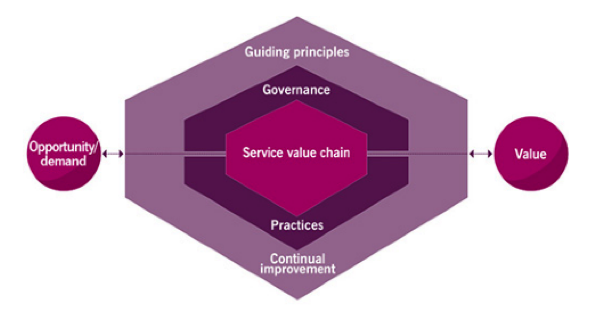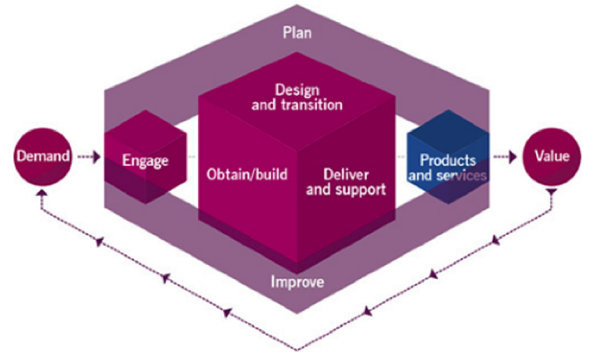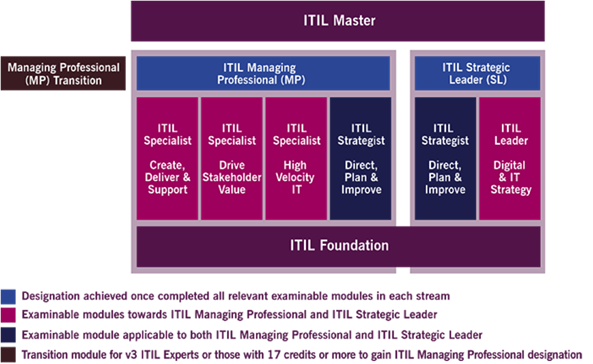Originally created in the late 1980s, ITIL got its fourth makeover in 2019. Out with the old, in with the new, as they say. This article explores what's new in ITIL 4, and what you and your organization need to know to get started using it. Let's dive in.
IT Jargon Explained
What is ITIL 4?
Why an Update Was Necessary
What led to this latest update? To understand, let's first examine the history of this framework.
The first version of ITIL was published in 30 separate volumes and released over a 12-year period beginning in 1989. ITIL Version 2 came out in the year 2000 and included a reorganization and refinement of the ITIL framework into eight publications.

The ITIL framework leaped forward in 2007, with the newly released ITIL V3 (also called ITIL 2007 edition) organized around the five stages of the IT service lifecycle. This framework had a strong emphasis on IT roles and responsibilities, as well as clearly defined processes and sub-processes for managing IT services from their initial strategic inception through to continual improvement and service termination.
In 2013, AXELOS, a joint venture set up by the UK Government and Capita, was established to manage manage ITIL and other Office of Government Commerce (OGC) best practice properties.
Aside from some minor updates in the ITIL 2011 release, the ITIL V3 standard remained the industry-leading framework for IT service management (ITSM) until the release of ITIL 4 in February 2019.
ITIL 4 represents a much-needed update to the ITIL framework. While ITIL V3 advanced process-oriented delivery of IT services and strengthened the relationship between IT services and business value, there were still many criticisms of ITIL V3:
- Too prescriptive and inflexible. Due to its heavy focus on processes and sub-processes, some IT professionals felt ITIL V3 compelled them to adopt elements of the framework that might not have been suitable for their unique circumstances.
- Lack of guiding principles. The organization of processes around a service lifecycle tells IT organizations what to do without necessarily explaining why or offering high-level guidance or core principles to follow. As a result, organizations using ITIL V3 lacked a set of reliable principles that could direct IT decision-making beyond the prescribed ITIL processes.
- Lack of emphasis on value delivery. ITIL V3's focus on service management processes meant that it overlooked some of the external factors that impact value creation, such as effective governance and working methods.
Prior to the release of ITIL 4, Stuart Rance, a long-time ITIL author and IT service management industry authority, described five key reasons why the ITIL V3 2011 Edition required updating:
- Excessive focus on process
- Siloed implementation
- Insufficient focus on value, outcomes, costs, and risks
- The need for support for digital transformation
- The need for compatibility with Agile, Lean, DevOps, and other management approaches
The update strives to reinforce linkages with business strategy while maintaining core ITIL elements from previous versions that are valuable. To that end, ITIL 4 has been redesigned and restructured to address these criticisms and ensure that ITIL remains the most relevant international framework for IT service management.
How ITIL 4 Is Different from ITIL V3
ITIL 4 represents a fundamental reorganization of the ITIL framework with an increased focus on the concepts of value, cost, and risk. The new framework includes many of the same components as ITIL V3 while incorporating updated knowledge and concepts that reflect a more value-oriented focus to IT service delivery.
The most obvious changes in ITIL 4 are the loss of the ITIL V3 service lifecycle terminology and imagery, and changes to the elements that comprised it: service strategy (there’s now a strategy management practice—more on “management practices” in a minute), service transition (there’s now “Design and transition” in the service value chain shown below), and service operation (there’s now “Delivery and support” in the service value chain). The most significant structural update to ITIL is the organization of the framework around two core components: the ITIL Service Value System (SVS) and the Four Dimensions Model.
The new ITIL Service Value System describes the chain of activities necessary to convert a business opportunity or demand for a service into business value. The IT service lifecycle has been refined into a new operational model known as the ITIL Service Value Chain that acts as the core component of the SVS. These changes reflect ITIL 4’s new focus on “the co-creation of value.”
Service Value System


Source: AXELOS, “ITIL Foundation, ITIL 4 Edition” (2019)
The Four Dimensions Model is a new version of the 4P's Model that was represented in ITIL V3, which included people, products, partners, and processes. The Four Dimensions Model addresses:
- Organizations and people
- Information and technology products
- Partners and suppliers
- Value streams and processes
IT organizations are encouraged to assess the impact, value, costs, and risks associated with each of the 4Ps in each component of the service value system.
As to the “management practices” point above: first, the 26 ITIL V3 processes have been replaced with ITIL 4 management practices. Some of the V3 processes have maintained their ITIL V3 name, while others have been renamed, and new processes have been added. There are now 34 management practices in total—divided into general management, service management, and technical management categories.
In "ITIL® Foundation, ITIL 4 Edition," a guide put out by AXELOS, these management practices are defined as: “A set of organizational resources designed for performing work or accomplishing an objective.” So, more than the processes of old.
Take a look at a quick summary of the management practices:
|
General management practices |
Service management practices |
Technical management practices |
|
Architecture management |
Availability management |
Deployment management |
|
Continual improvement |
Business analysis |
Infrastructure and platform management |
|
Information security management |
Capacity and performance management |
Software development and management |
|
Knowledge management |
Change control |
|
|
Measurement and reporting |
Incident management |
|
|
Organizational change management |
IT asset management |
|
|
Portfolio management |
Monitoring and event management |
|
|
Project management |
Problem management |
|
|
Relationship management |
Release management |
|
|
Risk management |
Service catalogue management |
|
|
Service financial management |
Service configuration management |
|
|
Strategy management |
Service continuity management |
|
|
Supplier management |
Service design |
|
|
Workforce and talent management |
Service desk |
|
|
Service level management |
||
|
Service request management |
||
|
Service validation and testing |
Source: AXELOS, “ITIL Foundation, ITIL 4 Edition” (2019)
Guiding Principles of ITIL 4
A common criticism of the ITIL V3 framework was that it lacked a set of overarching principles to inform the design and execution of ITSM processes. ITIL V3 was sometimes viewed as an overly prescriptive standard because it told IT organizations what processes to implement and when, but often failed to explain why or how a process should be managed in a specific way.
To address this issue, the ITIL 4 framework includes a set of seven guiding principles that ITIL practitioners can follow as they seek to drive value creation for their IT organizations. These guiding principles can play an important role in guiding IT decision-making and help IT managers develop their own strategies and conclusions in cases where the ITIL framework does not provide explicit guidance. Below, we describe each of the seven new guiding principles of ITIL 4.
- Focus on Value - The first guiding principle of ITIL reminds practitioners that their focus should always be on delivering value to the business, either directly or indirectly, through the effective management of IT services.
- Start Where You Are - The second guiding principle of ITIL reminds organizations not to throw out their existing systems when adopting the ITIL 4 framework. Instead, organizations are encouraged to preserve capabilities that meet their needs, improve them when necessary, and develop new ones when required.
- Progress Iteratively with Feedback - Big changes, even big improvements, can often lead to big problems that are difficult to measure or resolve. ITIL 4 practitioners are encouraged to improve their processes iteratively, collecting feedback and measuring success along the way to avoid setbacks. Change takes time. Slow and steady wins and changes should be measured for success before the organization builds on them further.
- Collaborate and Promote Visibility - ITIL 4 practitioners are encouraged to promote transparency and visibility of IT operations between team members, stakeholders, and partners. Increased visibility promotes communication and collaboration between departments, enables project and process owners to collect valuable feedback and insight from throughout the organization, and helps eliminate redundancies and information or knowledge silos.
- Think and Work Holistically - The fifth guiding principle of ITIL 4 encourages practitioners to assume responsibility for how their work fits into the overall service value system. No task exists in a vacuum and each action, sub-process, or process should be conducted with a view to minimizing risks and costs while delivering the greatest amount of value for the business.
- Keep It Simple and Practical - Simplicity and practicality are antithetical to the view that some practitioners have of ITIL as a prescriptive and inflexible framework. ITIL 4 addresses this criticism by directing its practitioners to simplify and right-size the use of processes, tools, and resources to match organizational needs. As a side note, ITIL V3's "processes" are called "practices" in ITIL 4, a change that reflects their newly emphasized flexibility for the needs of IT organizations.
- Optimize and Automate - The final guiding principle of ITIL encourages practitioners to automate and optimize processes wherever possible. Manual processes are easily forgotten or overlooked, error-prone by nature, and tedious and time-consuming. IT organizations should automate anything that they can, reserving human intervention for processes where it is genuinely necessary.
See a Demo: Ivanti Neurons for ITSM
The Importance of the Service Value System
ITIL 4's Service Value System represents a fundamental shift in emphasis away from the management of IT services and toward the creation of business value by the IT organization and its partners. The service value system describes the five key components of value creation and the relationships that exist among them while providing a new context for the IT service lifecycle, now called the service value chain.
The service value chain is the core element of the service value system and consists of six basic activities that encompass the lifecycle of IT services:
- Plan
- Improve
- Engage
- Design and transition
- Obtain/build
- Deliver and support
These activities are somewhat analogous to the IT service lifecycle that was the main organizational feature of ITIL V3. The old "Service Strategy" stage is reflected in three separate components of the new model: plan, improve, and engage. The old "Service Design" and "Service Transition" stages have been combined, with elements from both incorporated into the new obtain/build lifecycle step. The concept of "Continual Service Improvement" has been omitted from ITIL 4's service value chain and repositioned as a component of the overall SVS.
These changes reflect an increasingly value-driven service strategy that places more emphasis on planning services, collecting feedback, and understanding user needs and less emphasis on the actual design and implementation of services.
The SVS consists of four additional components beyond the re-imagined service value chain. We've already covered the seven guiding principles, but let's briefly touch on the other three: governance, practices, and continual improvement:
- Governance is the means by which an organization is directed and controlled. Corporate governance plays a role in the service value system by directing, controlling, and monitoring the delivery of services. Effective corporate governance drives the IT organization to maximize value creation while minimizing costs and mitigating risks where possible.
- Practices, under the ITIL 4 framework, have replaced the "processes" described in ITIL V3. While a process could be described as a series of activities performed sequentially to achieve a desired outcome, practices are simply organizational resources that can help accomplish an objective. ITIL 4 practices play a role in supporting the service value chain but should only be implemented when it is practical to do so from a value-oriented perspective.
- Continual improvement is a recurring theme throughout ITIL 4. It exists as a distinct component of the service value system, as one of the 34 practices, and in the context of the "continual improvement model," which provides organizations with a structured approach and methodology for planning, implementing, and assessing improvement.
Together, the five components of the SVS offer a blueprint for delivering value to the business through IT services. IT organizations, with the oversight of corporate governance and the insight of the seven guiding principles, execute on the six components of the service value chain while leveraging the 34 practices and seeking continual improvement of all service management and value delivery activities.
Related: More IT Jargon Explained
What Does ITIL 4 Mean for You and Your Organization?
The impact of the changes in ITIL 4 will depend on your organization's IT maturity level and previous exposure to the ITIL best practices framework. The broad perspective is that while many ITIL processes have remained the same, the framework itself has been reorganized and restructured to emphasize value generation and provide more guidance on how to realize value creation through the service value system.
New students of ITIL will need to familiarize themselves with the ITIL 4 qualifications and exam process. For those ITSM practitioners who’ve already adopted ITIL V3 best practice within their organization, it’s a case of digesting the changes and anticipating the impact they will have on their organization’s existing ITSM processes.
If you and your organization have never used ITIL before, the change will mean little relative to everything that has come and gone with the previous ITIL incarnations. But as to its timeliness and relevance, ITIL 4 is much more meaningful today than its predecessors, the 2011 Edition and the original 2007 ITIL V3.
If your organization provides IT services within your company, you may have already adopted many of the ITSM processes and sub processes that were described in ITIL V3. While these processes mostly remain unchanged, there is now much additional guidance outside of those processes that did not exist before. You may want to consider how factors like corporate governance are affecting operations throughout the value chain, and how you might apply the new Four Dimension Model and seven guiding principles to drive value generation for your organization.
If your organization provides IT services to its customers, they may expect you to update your IT service management practices and procedures to reflect the latest and best guidance. You may want to join thousands of other ITIL practitioners in the completion of the new ITIL 4 certification program. If you’re already knowledgeable about ITIL and in a role/company that provides ITIL-related services—for instance, consulting, training, or managed service provisioning—then incorporating ITIL 4’s principles will likely be a case of upskilling (and learning) in order to meet your clients’ needs and expectations. (Although managed service providers, out of the three examples, will likely have a delayed customer and prospect interest in ITIL-4-aligned capabilities versus those of ITIL V3.) Much will depend on customer insistence on ITIL 4 use over ITIL V3, but many will likely be more concerned with outcomes and costs versus “what’s behind the curtain.”
This might seem a leisurely approach, but the reality is that so far, only the ITIL Foundation content has been released. The 212 pages of the Kindle edition—while full of interesting content—only give the reader a high-level appreciation of the ITIL 4 approach to “service management” (note the lack of emphasis on “IT”—a deliberate change with ITIL 4). The truth is, it’s no different than any of the previous ITIL versions where the Foundation’s intention is to provide an introductory overview for those new to ITSM/service management. ITSM practitioners will have to wait patiently for the next ITIL 4 publications that will reveal more about the impacts of the new best practices on their organizations.
What Do the New ITIL 4 Qualifications Look Like?
AXELOS has shared the following ITIL 4 certification structure diagram, which shows ITIL 4 courses and certifications at the following levels:
- ITIL Foundation
- ITIL Specialist modules x3
- ITIL Strategist
- ITIL Leader
- ITIL Master

Source: AXELOS, “ITIL Foundation, ITIL 4 Edition” (2019)
The Foundation course is still the platform on which to build toward other ITIL qualifications. There’s no longer an ITIL Practitioner course and qualification available.
In addition to the existing ITIL Foundation and ITIL Master, the ITIL 4 certification scheme contains two new designations:
ITIL Managing Professional (ITIL MP) – which is aimed at IT practitioners working within technology and digital teams. It provides practical and technical knowledge.
ITIL Strategic Leader (ITIL SL) – which positions ITIL not just for IT operations but for all digitally enabled services.
To qualify as either an ITIL Managing Professional or ITIL Strategic Leader, the exam-taker must complete all modules in each stream.
How Will the ITIL 4 Update Affect Existing ITIL Qualification Holders?
This is one of the most frequently asked questions each time ITIL is updated.
Why? Because with each ITIL update comes new content, new qualifications, and new exams—often including “bridge exams” which take individuals from a previous version of ITIL (qualification) to the latest.
For example, someone with the ITIL V3 Foundation-level qualification—commonly called Foundation Certification or Certificate—might wish to acquire the ITIL 4 Foundation certificate in order to keep studying in pursuit of further ITIL certificates.
The AXELOS ITIL Update blog explains the mechanics of how to do this, that:
- All ITIL certifications will remain valid following the update.
- All credits gained can be transitioned to the new certification scheme. AXELOS recommends that candidates continue to collect the 17 ITIL V3 credits necessary to take the ITIL Managing Professional Transition module (one course, one exam).
AXELOS also provides more detailed advice for people with ITIL V3 certifications looking to transition to ITIL 4 qualifications:
ITIL V3 Foundation – it’s recommended that certification holders undertake ITIL 4 Foundation to transition to the new scheme.
ITIL V3 Intermediate (three or four credits achieved) – there are two recommended options for people at this point of qualification. They are encouraged to:
- Take ITIL 4 Foundation and a further module in their preferred area of interest.
- Achieve 17 credits from ITIL V3 to be eligible for the ITIL Managing Professional transition module.
ITIL Intermediate/Practitioner (six or more credits achieved beyond Foundation) – continue to collect V3 credits for an easy transition to ITIL 4 and the ITIL Managing Professional qualification. 17 credits are needed to take the ITIL Managing Professional Transition module.
ITIL V3 Expert – take the ITIL Managing Professional Transition module to achieve the ITIL Managing Professional qualification.
If all of this just seems like a jumble of ITIL-qualification-related terminology, then this flowchart might be a more helpful way of understanding the impact of ITIL 4 on your ITIL V3 qualifications.
How Will ITIL 4 Affect the Pink Elephant PinkVERIFY ITSM Tool Certification Scheme?
If you’re looking to invest in a new ITSM tool, then you might use the Pink Elephant PinkVERIFY tool certification scheme—described by Pink Elephant as “an internationally recognized ITSM tool suite assessment service”—as an input to your tool-selection decision making.
The currently available set of Pink Elephant tool assessments is called PinkVERIFY 2011 Toolsets. This will no doubt need to be updated to reflect not only the new ITIL 4 name but also any changes to ITIL’s structure and scope the update brings. But so far there have been no announcements from Pink Elephant as to what will happen.
Related: What is ITSM?
How To Get Started
For many ITIL practitioners, especially those who aren’t consultants, trainers, nor ITIL students, there will be little urgency to get started with ITIL 4. These ITSM practitioners may be better off waiting for the release of additional ITIL 4 publications before deciding what could or should change for their organizations.
In the meantime, however, it’s a great opportunity to take the time to see what has changed (at a Foundation level of detail), assessing not only if, but also how, it impacts your current ITIL approach. Plus, you may find there are significant changes or additions that would be beneficial enough to extend the scope of your ITIL use now, rather than later.
If there are some Foundation-level changes you believe are sufficiently valuable to adopt now, you could bite now, start to benefit earlier, then potentially roll out another phase of changes as the additional publications and resources become available. Or you could wait until more detailed guidance is released and implement all the changes at once as part of a larger (and potentially more complex) project.
Ultimately, the choice is yours. And rest assured, whatever approach you decide to take, you and the business you support will benefit significantly from the new, more outcome-focused guidance found within ITIL 4.
Conclusion
ITIL 4's expanded guidance and emphasis on value creation is likely to cause a significant shift in the way that organizations manage IT services. The service value system and four dimensions model increase the scope of the framework beyond IT processes to include every aspect of IT service delivery and value creation.
The Impact ITIL 4 Will Have on ITSM Tools
If your organization relies on ITSM software to support its service management processes, you may be wondering how implementing the new ITIL 4 framework will affect your current ITSM tool.
Most popular ITSM software tools have been designed to support and automate ITIL V3 processes, but the marketing of these tools has shifted away from an emphasis on alignment with ITIL processes. With ITIL 4 gaining steam, we're expecting a resurgence of marketing campaigns from ITSM tool vendors that emphasize ITIL 4 alignment.
It is also worth noting that at the time of this publication, only the ITIL Foundation book of ITIL 4 has been published. With more publications to follow, it remains to be seen whether ITSM tool vendors will need to modify their existing tools or create new ones to support ITIL 4 requirements.
*This content originally appeared on Cherwell.com, prior to the acquisition by Ivanti.